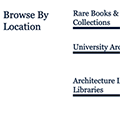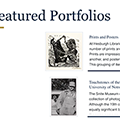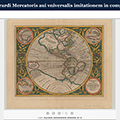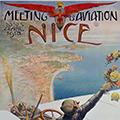Marble platform launches for online access to cultural heritage collections at Notre Dame

MILESTONE 57 — On July 21, 2021, the Hesburgh Libraries and the Snite Museum of Art (now Raclin Murphy Museum of Art) announced the launch of Marble (Museums, Archives, Rare Books, and Libraries Exploration).
The unified discovery platform, which is free and open to the public, was designed to make distinctive cultural heritage collections from across the University accessible through a single portal. The platform's development was made possible, in part, by a three-and-a-half-year grant announced in March 2018 from The Andrew W. Mellon Foundation.
University officials believed the new platform would have a transformational effect on research, teaching and learning at Notre Dame and other institutions facing similar needs.
When the project began in 2018, former provost Thomas G. Burish said, “Notre Dame is blessed with extraordinary library and art collections, including artifacts that have unique historic, cultural and religious significance. We are grateful to the Mellon Foundation for providing us the means to share these collections more broadly with scholars as well as the public.”
When the platform launched in 2021, former provost Marie Lynn Miranda said, “Thanks to the hard work of so many in the Hesburgh Libraries and Snite Museum of Art and the generosity of the Mellon Foundation, Notre Dame is transforming the way scholars on campus and around the world further knowledge and advance research. It’s a wonderful privilege for Notre Dame to play a role in preserving these important cultural heritage collections and in making those collections easier to access, explore, and investigate.”
A unified solution helps to solve a long-standing problem
University libraries and museums nationwide have long sought solutions that would enable their collections and artifacts to be easily discovered online.
However, museums and libraries have historically been independent gateways for faculty and students to engage with scholarly resources, research tools, historical information and cultural objects. Users can access the physical collections at different locations, but not all resources are available online. Collection management systems are optimized for each respective field, but they do not interact well with each other. Thus, scholars are unable to conduct expansive research across these university holdings efficiently.
A cross-disciplinary team developed Marble to address this universal challenge and to help transform teaching and research at Notre Dame and other institutions facing similar needs.
“The museum is grateful to be a part of this research partnership and the initial phase of the Marble project,” said Joseph Antenucci Becherer, director of the Snite Museum, about the launch. “Offering the academy, and all users, access to our collections is deeply meaningful and useful in guiding the future of both research and teaching, not to mention pure enjoyment for even the more casual, curious user.”
New features transform how scholars interact with distinctive collections
The platform's goal was to make it easier for digitized collections to be used in teaching and research. It not only made the collections available digitally but also standardized practices and metadata that would make it easier for the items to be discovered and researched.
“Marble offers key features that fundamentally transform the way digital collections can be used for teaching and research,” said Diane Parr Walker, the Edward H. Arnold University Librarian at the time of the launch. “The museum and library collaboration and the grant outcomes will have a transformational impact on pedagogical access, scholarly engagement and research outcomes at Notre Dame.”
Marble users have the ability to browse, select and download the digitized materials on the platform, which include books, manuscripts, sculptures, paintings, photographs, ephemera and more. Each item displays one or more images with descriptive information and linked metadata to view related or similar items. While viewing the items in the collection, users are able to zoom in, rotate, manipulate color, and have comparable viewing and options for cross-institutional research.
At the heart of Marble is an open-source image-sharing system called IIIF, or the International Image Interoperability Framework. IIIF is a set of universal specifications that provide a standardized way of storing and displaying images. One of the benefits of using IIIF images is that they can be viewed alongside other IIIF-compliant images from institutions worldwide. IIIF also has a suite of enhanced, 24/7 viewing features, including zoom, rotation, color manipulation, comparable viewing and options for cross-institutional research. With IIIF, end-users have a seamless view and a powerful research experience.
A Portfolio tool turns members of the Notre Dame community into curators, allowing each person to create customized lists and collections of content. Users browse, search, and easily save items of interest into portfolios for future viewing. Portfolios are versatile — they can be shared for teaching, used for course assignments or annotated for individual research. They are permissions-based, so they can stay private or be shared with students, campus peers, or the public.
Freely available, scalable solutions advance museum-library collaborations
Notre Dame shares the Mellon Foundation’s commitment to advancing museum-library collaborations through freely available, scalable solutions.
Marble’s software is optimized for the cloud, making it more scalable and less costly than software deployed on a local network infrastructure. It features a shared administrative back-end to calibrate data entry and optimize collection management workflows for both library and museum environments. The development roadmap continues to reduce technological and administrative barriers that have hindered collaboration between libraries and museums and enable new features that advance research and teaching opportunities with digitized collections.
The project was published through several open-access channels, including Notre Dame’s institutional repository, CurateND. Outcomes were also widely shared with library, museum and open-source development communities.
The code for the Marble project was developed by the Hesburgh Libraries development team. It is open by default and published on GitHub. The Open Science Framework publishes documentation, collaborative processes and best practices.
Online access to these selections of distinctive cultural heritage materials at Notre Dame is free and open to the public — visit marble.nd.edu often to see new materials and featured portfolios.





